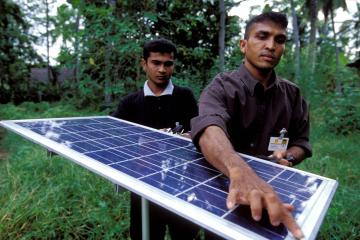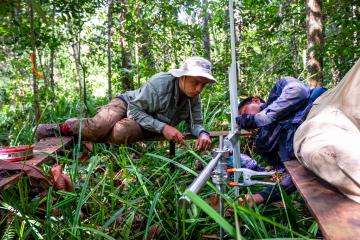
Two lessons from the landmark IPCC report on climate change

The UN Intergovernmental Panel on Climate Change (IPCC) recently released the Working Group I Sixth Assessment Report: The Physical Science Basis, a major update to the state of knowledge on the science of climate change. The report is also an urgent call to action. Rapid large-scale reductions in greenhouse gas emissions and adaptation solutions are needed to avoid the worst effects of climate change.
The implications of the report extend beyond the world of climate science to J-PAL and others focused on poverty alleviation. Climate change’s impacts, such as heatwaves, heavy rainfalls, and droughts, disproportionately affect people experiencing poverty worldwide and threaten to reverse decades of progress in poverty alleviation.
The report concludes that human-induced climate change is already affecting weather and climate extremes in every region, and projected increases in the frequency and intensity of these events will only exacerbate pressure on vulnerable communities.
To develop high-impact solutions that reduce emissions and strengthen communities’ ability to adapt to climate change, we need more evidence on policy and technology solutions at the nexus of climate change and poverty alleviation and must ensure that existing evidence informs policy decisions.
Act urgently and effectively to reduce greenhouse gas emissions
In order to prevent the worst effects of climate change, greenhouse gas emissions need to be deeply reduced as soon as possible. Low- and middle-income countries produce the fewest greenhouse gas emissions, yet they also feel the sharpest effects of climate change.
The report considers five different carbon dioxide (CO2) emissions scenarios, including the associated temperature increases and impacts for each. Under all scenarios, temperatures will increase until at least 2050, and in only two scenarios are increases below 2.0°C. We have a short window to achieve these two now best-case scenarios. Although some consequences of climate change can no longer be avoided, significantly reducing emissions can help us avoid the direst effects, such as rising sea levels and increased frequency and intensity of extreme weather events.
For solutions to be effective, it is crucial to test them in real-world settings. Proven solutions to mitigate greenhouse gas emissions already exist. For example, a randomized evaluation led by J-PAL affiliated professor Seema Jayachandran and coauthors tested the effectiveness of a program that paid Ugandan landowners to not cut down their trees. The evaluation found that the program reduced deforestation in the areas covered by the contracts, without increasing deforestation in neighboring forests. The program was able to pause CO2 emissions at less than US$1 per metric ton, making it a potentially cost-effective solution.
Still, further evidence to abate emissions and mitigate climate change is needed. A current randomized evaluation, led by Robert Metcalfe and supported by J-PAL’s King Climate Action Initiative (K-CAI), is measuring how changing management practices can impact fuel efficiency and possibly reduce CO2 emissions in the shipping industry. By continuing to generate evidence, we can learn how to best achieve large emission reductions even in sectors where abatement is challenging, and contribute to both slowing climate change and alleviating poverty.
Build resilience of communities most harmed by climate change
No matter how much we manage to reduce emissions, the impacts of climate change are guaranteed to increase over the next 30 years. We need to find effective adaptation solutions that benefit those most vulnerable to climate change. The findings from IPCC’s 2014 report on adaptation and vulnerability highlights that “Climate-related hazards exacerbate other stressors, often with negative outcomes for livelihoods, especially for people living in poverty.”
A major addition to IPCC’s Sixth Assessment Report, compared to previous reports, is a better understanding of how climate change will differ across regions. The report’s interactive atlas shows climate change impacts across geographies, highlighting areas that are more exposed to climate change. Across all regions, low-income communities have fewer resources to adapt and be resilient to climate change.
Efforts in international development and poverty alleviation should integrate a climate lens into their work to help develop a toolkit of evidence-informed solutions that build resilience for vulnerable communities. For example, an evaluation led by J-PAL affiliated professor Karen Macours and coauthors studied how conditional cash transfers could help households in rural areas in Nicaragua diversify their income and, in turn, increase their resilience to weather shocks.
Still, like for reducing emissions, further evidence is needed. K-CAI is supporting India’s first randomized evaluation of a flood early warning system for low-income communities, led by J-PAL affiliate Rohini Pande and Maulik Jagnani. By generating new evidence on adaptation strategies, we will be better equipped to help low-income communities and countries become more resilient to the effects of climate change.
Learn more
Given the findings of IPCC’s latest climate report, and in anticipation of the Impacts, Adaptation, and Vulnerability and Mitigation of Climate Change reports to be released next year, we need to continue generating research and scaling climate solutions proven to be effective in real-world settings, to both mitigate climate change and increase resilience to its increasing impacts.
If your agency or organization is interested in evaluating a program or policy, the K-CAI team is glad to facilitate connections with potential partners and J-PAL’s network of affiliated researchers. Please contact us at [email protected].
To stay up to date with environment, energy, and climate change research, updates on K-CAI funded projects, and related policy lessons, subscribe to our mailing list and mark “Environment, Energy, and Climate Change” as a sector interest area.


